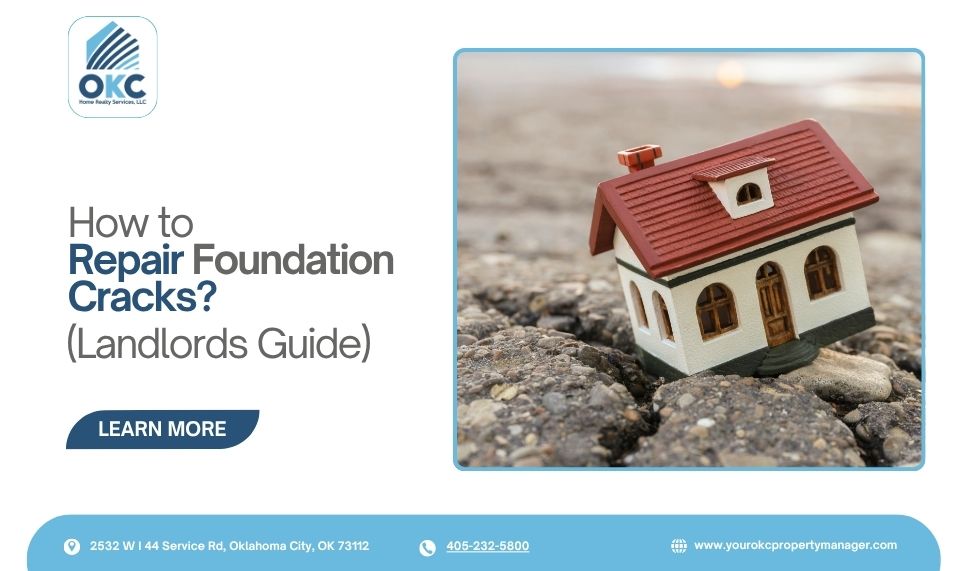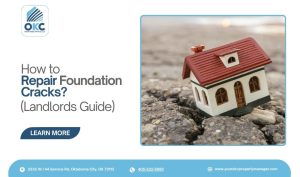I’ll never forget the day a tenant called me about “a little crack” in their basement. Twenty years in property management has taught me that “little cracks” are rarely just little. When I walked into that property, I found a quarter-inch horizontal crack running across the foundation wall; exactly the kind that makes experienced landlords lose sleep.
Foundation crack repair is one of those landlord headaches that never comes at a convenient time. Knowing how to repair foundation cracks can save you thousands in emergency fixes and protect your investment from serious structural damage.
What most property owners don’t realize is that not all foundation cracks require expensive professional intervention and minor settling issues can often be addressed with DIY solutions. However, horizontal cracks, bowing walls, or cracks wider than a quarter-inch? Those need immediate professional assessment.
In this blog, I’ll walk you through how to spot foundation cracks, understand what causes them, and decide when it’s safe to handle repairs yourself and when to call in a professional.
Understanding Foundation Cracks
Before you can fix a foundation crack, you need to understand why it’s there in the first place. I learned this lesson after spending $1,200 patching cracks that kept coming back every spring. Turns out, I was treating the symptom instead of addressing the root cause; poor drainage that was flooding the foundation every time it rained.
The truth is, some cracking is completely normal. Concrete naturally shrinks as it cures, and every building settles over time. But other cracks signal real problems that will only get worse if ignored. Knowing the difference between “monitor this” and “fix this now” is what separates smart landlords from those facing five-figure repair bills.
What are the Common Causes of Cracks in Foundation?
Foundation cracks usually result from a combination of soil movement, moisture changes, and construction factors. Here are the most common causes I’ve seen over two decades of property management:
- Soil Expansion and Contraction: According to U.S. Geological Survey (USGS), clay-rich soil absorbs water and expands, then contracts during dry periods. This constant push-and-pull creates tremendous pressure on your foundation walls.
- Poor Drainage: When water pools around your foundation, it creates hydrostatic pressure against basement walls and weakens concrete walls.
- Weather Extremes: Hot summers followed by sudden storms create rapid moisture shifts. For example, homes in Moore and Edmond often experience cracking after long dry spells followed by heavy rain.
- Tree Roots: Large trees too close to your foundation pull moisture from the soil, causing uneven drying and cracking.
How to Identify Different Types of Foundation Cracks?
Not all foundation cracks are created equal and each type of crack tells a different story. Here’s how to identify the most common types:
- Vertical cracks: These run straight up and down, usually appearing near corners or windows. These are typically the least concerning; often just normal settling. If they’re thinner than 1/8 inch and not leaking, they’re usually just cosmetic.
- Horizontal cracks: These indicate serious pressure against your foundation wall, often from soil or water pushing inward. If you see horizontal cracks, especially in basement walls, call a professional immediately.
- Diagonal (stair-step) cracks: These angle across your foundation, often following mortar joints in block foundations. These usually mean differential settling; one part of your foundation is sinking faster than another.
- Hairline cracks: These are superficial surface cracks, usually less than 1/16 inch wide. These are almost always cosmetic from concrete curing.
How to Fix a Cracked Foundation by Yourself?
There’s no fixed rule that every foundation crack needs professional repair. Many small, non-structural cracks can be fixed with basic tools and materials from your local hardware store. Over the years, I’ve guided countless landlords through simple repairs that prevent bigger problems later. The key is to act early, follow the right steps, and use quality materials designed for concrete.
Here’s a step-by-step guide to repairing minor foundation cracks safely and effectively:
Step 1: Inspect and Measure the Crack
Start by determining whether the crack is cosmetic or structural. Measure its width and note any changes over time. Take photos from multiple angles. Check if it’s actively leaking by running your hand along it. If you feel moisture, DIY isn’t appropriate for water-active cracks.
- Hairline cracks (less than 1/8 inch): Usually safe for DIY repair.
- Cracks wider than 1/4 inch: May indicate foundation movement and should be evaluated by a professional.
Tip: Use a flashlight to check for moisture or damp spots, especially after rain.
Step 2: Clean the Area Thoroughly
I learned the hard way that patching over dirty cracks just wastes product; the repair won’t bond properly.
- Use a wire brush or chisel to remove loose concrete.
- Blow out dust with an air compressor or vacuum.
- If there’s any mold or mildew, scrub it off with a water and bleach solution.
Step 3: Choose Your Repair Method
For small, dry, non-structural cracks, I typically reach for hydraulic cement or concrete crack filler; both available at any hardware store for $15-30. For slightly larger vertical cracks (up to 1/8 inch), epoxy paste works better because it actually bonds the concrete together rather than just filling the gap.
Consider these options:
- Hydraulic cement: Best for surface cracks, sets quickly, expands as it cures
- Concrete crack filler: Good for very thin hairline cracks, flexible formula
- Epoxy paste: Strongest option for structural bonding, more expensive but worth it for larger cracks.
- Polyurethane Foam: expands on contact with moisture, filling the crack and stopping water flow.
Step 4: Apply the Repair Product
Follow manufacturer instructions exactly. With hydraulic cement, you’ll mix it to a putty consistency (think peanut butter thickness) and press it firmly into the crack with a putty knife. Work from bottom to top to prevent air pockets. Overfill slightly as it’ll shrink as it cures, and you want complete coverage.
Application tips:
- Dampen the crack first for better adhesion
- Pack material deep into the crack, not just surface level
- Remove air bubbles by pressing firmly
Step 5: Finish and Seal
Once cured (usually 24 hours, but check your product), smooth any excess with sandpaper or a concrete rubbing stone. The surface should be flush with the surrounding wall. Then apply a quality concrete sealer to help prevent future moisture intrusion; this step protects your repair and the surrounding concrete.
- Wait full cure time before sealing
- Apply sealer to entire wall section, not just the repair
- Reapply sealer every 2-3 years for ongoing protection
When Should You Seek Professional Help?
If I have to be honest, I’ve done plenty of DIY home foundation repairs over the years, but only on specific types of cracks. Attempting to fix serious structural issues yourself is like performing surgery after watching a YouTube video; technically possible, but probably a terrible idea. You need to call a professional immediately if you see:
- Cracks Wider Than 1/4 Inch: When a crack reaches or exceeds a quarter inch, it usually indicates that the foundation is shifting or settling unevenly. This type of movement can’t be fixed with surface repairs, as the problem often extends deep into the soil. Professionals can assess whether piering, underpinning, or soil stabilization is needed to restore stability.
- Horizontal or Stair-Step Cracks: These cracks typically form excessive lateral pressure on basement or crawl-space walls. In Oklahoma’s clay-rich, moisture expansion can push against concrete until it blows or fractures. Such cracks signal structural stress, and a professional should evaluate the wall’s laid-bearing capacity immediately.
- Active water leakage: If water is seeping or pooling through cracks, you’re dealing with hydrostatic pressure issues. DIY surface patches won’t solve this; you need a proper waterproofing and possibly drainage solutions.
- Uneven Floors and Misaligned Doors or Windows: When doors no longer close properly or floors slope, it’s often due to foundation settlement. This uneven movement requires elevation testing and structural adjustments that go beyond cosmetic patching.
- Multiple new cracks appearing quickly: When you see several cracks developing within weeks or months, it signals ongoing foundation movement. This requires professional diagnosis to identify the root cause.
- Previous repairs that failed: If you’ve patched a crack and it reopened, the underlying issue wasn’t addressed. Professionals have tools to identify what’s actually causing the movement.
In my experience, Oklahoma’s fluctuating soil moisture and extreme weather can turn minor cracks into major repairs almost overnight. A professional inspection provides a detailed assessment of soil conditions, drainage, and structural integrity; giving you a clear repair plan before the damage worsens.
Foundation Maintenance Made Easy with Professional Property Management
Foundation cracks can happen; some are just cosmetic settling you can patch yourself on a Saturday afternoon while others mean it’s time to call the pros before things get expensive. The trick is catching problems early and knowing which battles to fight yourself.
But the thing is: between tenant emergencies, maintenance calls, and everything else on your plate, who has time to inspect foundations? This is exactly why so many Oklahoma landlords work with OKC Home Realty Services. We handle routine property inspections, identify foundation issues early, and coordinate qualified contractors before small cracks become major problems. Instead of waiting for that panicked tenant call about a crack, let us handle the monitoring and maintenance. You’ll sleep better, and your property stays protected.
Want to stop stressing about foundation problems? Visit OKC Home Realty Services at 2532 W I 44 Service Rd, Oklahoma City, OK 73112, or book your free consultation today! Let’s talk about keeping your investment safe.
FAQs About Foundation Cracks Repair
What is the best way to repair foundation cracks?
The best repair method depends on the crack type and severity. For minor hairline cracks, hydraulic cement or epoxy paste works well for DIY fixes. Larger structural cracks require professional solutions like epoxy injection, carbon fiber reinforcement, or foundation underpinning.
Is it better to repair foundation cracks from inside or outside?
Interior repairs are easier and more cost-effective for minor cracks. However, exterior repairs address the root cause by waterproofing and managing drainage, making them more effective for preventing future water intrusion and long-term foundation protection.
What is the best time of year for foundation repair?
Spring or fall is ideal since moderate temperatures and dry weather ensure good curing conditions and access around the foundation.
Does home insurance cover foundation repair?
Usually, standard home insurance does not cover foundation repairs unless damage was caused by a covered peril like a sudden event or natural disaster.
How to stop house foundations from cracking?
Maintain proper drainage with gutters, downspouts, and grading that directs water away from your foundation. Keep soil moisture consistent by watering during dry spells, and avoid planting large trees too close to your home.
How to fix stair step cracks in foundation?
Stair-step cracks indicate differential settling and typically require professional assessment. Small stair-step cracks can be filled with epoxy, but larger ones often need foundation stabilization through piering or underpinning.

Author
Scott Nachatilo is an investor, property manager and owner of OKC Home Realty Services – one of the best property management companies in Oklahoma City. His mission is to help landlords and real estate investors to manage their property in Oklahoma.
 (
(









